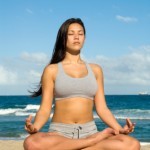 By Sanjeev Patel
By Sanjeev Patel
The sitting postures of Hatha Yoga are important as ideal postures for a correct practice of Pranayama and meditation, apart from limbering legs and hips, strengthening the back and improving the posture. They are the most efficient postures of the body to allow psychophysical energy to flow freely with maximum relief of tension.
The Easy Posture or Sukhasana is the most approachable of the sitting postures and the most suitable to beginners or practitioners with knee, ankle or hip limitations. Simply sitting with a straight spine from tailbone to head, relaxed shoulders, bent legs and crossed ankles, knees relaxed and lowered to the floor or where reachable without strain. Always sitting firmly on the buttocks, each hand relaxing on the correspondent knee. Free and deep breathing.
Sitting Postures
The Perfect Posture or Siddhasana is achieved by folding the legs with one heel touching the perineum area of the body (between genitals and anus) and the other heel pulled towards the pubic region with the sole of the foot resting in the fold made by calf and thigh of the lower leg. Back is straight and hands rest again on each correspondent knee. It’s called perfect for its great stability and it’s commonly used by Yogins in meditation.
The Hidden Posture or Guptasana, also called Free Posture or Mukthasana, resembles the preceding Perfect Posture, except that the lower leg is against the opposite thigh rather than the perineum, and the ankles are crossed so that the heels of the upper foot rests against the pubis.
In the Prosperous Posture or Swastikasana, also called Ankle Lock Posture, the ankles are crossed so that each foot is inserted between the thigh and calf of the opposite leg. The knees are kept down on the floor.
The Half-lotus Posture or Ardha–padmasana, resembles the Perfect Posture, except that one foot is upturned on top of the opposite thigh and against the groin. The other foot is pulled in against the perineum or the root of the opposite thigh.
The Lotus Posture or Padmasana, is the classic posture of meditation in the East and the very symbol of the meditating Yogin. Sometimes it’s called the Buddha Posture.
In this posture the body is supported firmly on the buttocks and thighs, the spine is erect, and head and neck are in line with the spine. Each foot is pulled up on to the opposite thigh and in against the groin, with the sole upturned.
The Bound Lotus Posture or Banda Padmasana, resembles the Lotus Posture, except that the arms are crossed behind the back and each hand grab the toes of the correspondent foot, with the chest moving forward and expanding.
In the Auspicious Posture, the knees are spread wide out to the sides and the soles and heels are brought with the heels against the perineum. The knees touch the floor and the feet are pulled together and kept in the position by the hands. Spine and head are in vertical line. The hands may be placed on the knees when the posture is employed for meditation.
© Copyright – Aura Wellness Center – Publications Division
Please feel free to share our posts with your friends, colleagues, and favorite social media networks.

Hatha Yoga asanas are the most efficient postures of the body to allow psychological energy to flow freely with maximum relief of tension. Thanks for posting this nice article.
Thank you very much for sharing this valuable guideline about hatha yoga posture.